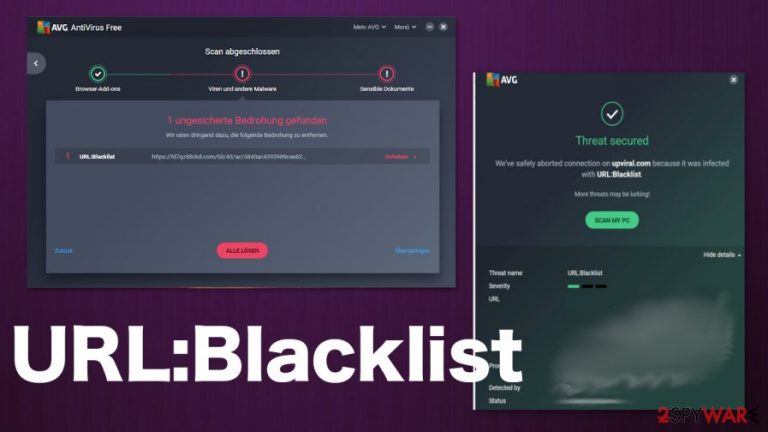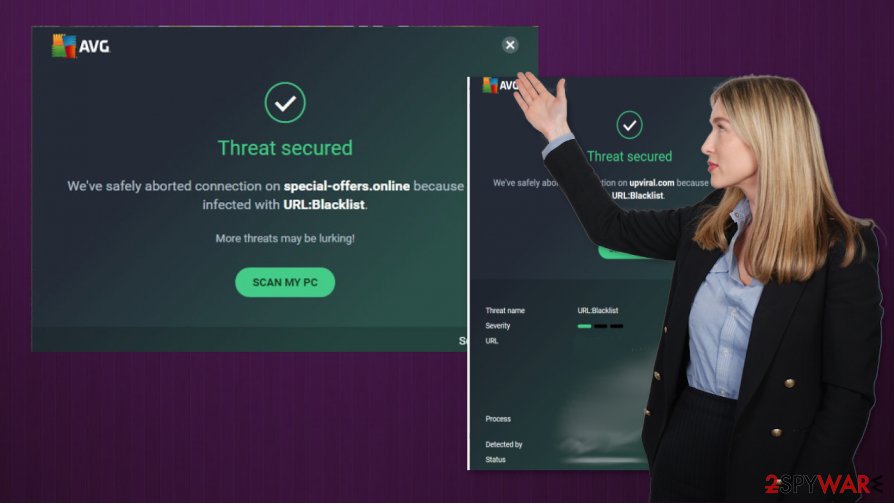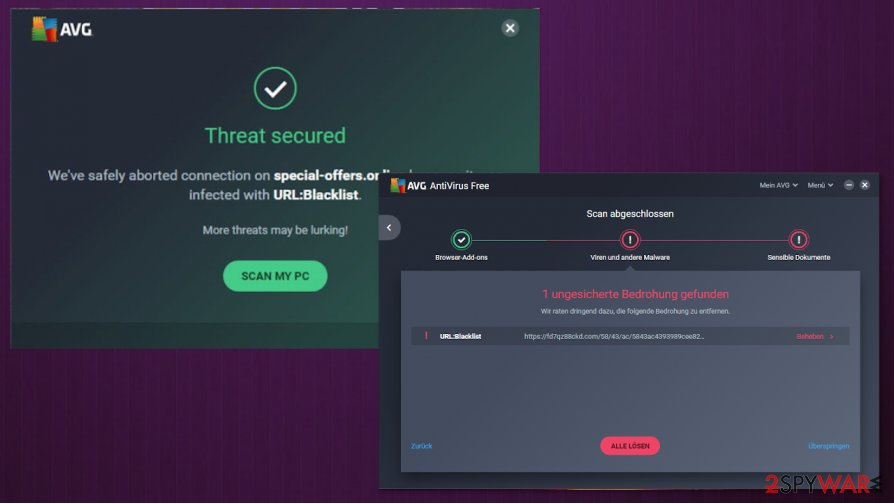URL:Blacklist (Free Guide) - Removal Instructions
URL:Blacklist Removal Guide
What is URL:Blacklist?
URL:Blacklist is the false positive malware detection notification that mainly alerts about possibly dangerous URL that you visited

| Name | URL:Blacklist |
|---|---|
| Type | The virus detection alert that can possibly be related to adware or more dangerous cyber threat. This is possibly a false positive notification[2] |
| Issues | Browser crashes out of nowhere and pop-ups, random redirects, advertising material |
| Distribution | Freeware installations processes, other potentially unwanted programs, or malicious sites can all lead to a threat infiltration |
| Elimination | You can remove URL:Blacklist if needed with a powerful anti-malware tool. System scan using the additional program to the one that you already use can help determine the particular issue with this detection alert |
| System repair | You might benefit from a program like FortectIntego that checks for affected files or virus damage, so your device starts running smoother |
This is the detection that occurs on the AVG program, so that might be false-positive and triggered by some site or stealthy intruder. It is best to check for any other approval from a separate anti-malware tool. It any of those cannot detect URL:Blacklist on the system, you should think about rerunning the scan using your primary tool or switching to another engine/ malware removal tool entirely.
The message from the antivirus detection engine states about aborted connection or malicious site, block URL or says nothing at all just that the URL:Blacklist virus got terminated, so your system is secure. The alert pop-up also shows a particular path to the file or the connection to the site.
You can determine if the site is an advertising service or shady website with commercial content delivery. If so, you can be sure that the alert is related to adware-type infection[3] or a rogue website that triggers additional issues with the system, so you can remove URL:Blacklist with the help of anti-malware tools, other security programs. Check the machine using SpyHunter 5Combo Cleaner or Malwarebytes to know for sure.

Trust proper tools and check if the URL:Blacklist detection is showing up on more than one AVG tool. These warnings' frequent appearance can indicate many different things, but always pay attention to the site or file that triggers these issues.
URL:Blacklist removal can be quick if you start with a web browser resetting and checking the system fully with another anti-malware tool or similar software. There are some compatibility issues too that can trigger false positives. When you run a few anti-malware or security tools at the same time, you can suffer from such messages.
Try to disable one and run the other to see what happens then and if the detection about URL:Blacklist appears again. Also, once you get the pop-up – check the site or file that triggered the detection yourself. You might need to tackle file issues or virus damage, so run FortectIntego to find any problems and possibly fix them. 
PUP spreading ways
These questionable antivirus tool alerts about detection or malicious sites, files you visit or want to download can appear in various instances. Mostly, users claim that pop-ups, warnings, and threat indications show up on the machine when the site is accessed or file download starts.
These suspicious appearances can be related to threats or triggered by the adware-type intruder, for example. It is common, especially when you tend to visit advertising services and similar pages with shady purposes. You need to avoid rogue sites and PUP infiltrations during freeware installations.
Go for legitimate sources of applications and programs, so you can avoid software bundling. Or always rely on Advanced/ Custom options, so the control is in your hands only and you are the one that allows or denies the installation of a file.
You might need to get rid of this URL:Blacklist virus with proper AV tools
The first thing you need to know about URL:Blacklist removal is the diagnosis and further examination of a trustworthy anti-malware tool. It is better to use another tool, not the one that showed you these alerts. It is better for double-checking.
Run a tool that can possibly remove URL:Blacklist if needed and see if the issue is detected too. If not – you might want to change the antivirus security provider, or reinstall the software, ask for help from support. You can rely on the tips below and fully reset the web browser that received alerts, so the browser-based threat gets eliminated.
You may remove virus damage with a help of FortectIntego. SpyHunter 5Combo Cleaner and Malwarebytes are recommended to detect potentially unwanted programs and viruses with all their files and registry entries that are related to them.
Getting rid of URL:Blacklist. Follow these steps
Uninstall from Windows
You can try to find the associated intruder on the machine that triggers these alerts and other symptoms
Instructions for Windows 10/8 machines:
- Enter Control Panel into Windows search box and hit Enter or click on the search result.
- Under Programs, select Uninstall a program.

- From the list, find the entry of the suspicious program.
- Right-click on the application and select Uninstall.
- If User Account Control shows up, click Yes.
- Wait till uninstallation process is complete and click OK.

If you are Windows 7/XP user, proceed with the following instructions:
- Click on Windows Start > Control Panel located on the right pane (if you are Windows XP user, click on Add/Remove Programs).
- In Control Panel, select Programs > Uninstall a program.

- Pick the unwanted application by clicking on it once.
- At the top, click Uninstall/Change.
- In the confirmation prompt, pick Yes.
- Click OK once the removal process is finished.
Delete from macOS
Remove items from Applications folder:
- From the menu bar, select Go > Applications.
- In the Applications folder, look for all related entries.
- Click on the app and drag it to Trash (or right-click and pick Move to Trash)

To fully remove an unwanted app, you need to access Application Support, LaunchAgents, and LaunchDaemons folders and delete relevant files:
- Select Go > Go to Folder.
- Enter /Library/Application Support and click Go or press Enter.
- In the Application Support folder, look for any dubious entries and then delete them.
- Now enter /Library/LaunchAgents and /Library/LaunchDaemons folders the same way and terminate all the related .plist files.

Remove from Microsoft Edge
Try to fight the suspicious threat and reset Edge to default fully
Delete unwanted extensions from MS Edge:
- Select Menu (three horizontal dots at the top-right of the browser window) and pick Extensions.
- From the list, pick the extension and click on the Gear icon.
- Click on Uninstall at the bottom.

Clear cookies and other browser data:
- Click on the Menu (three horizontal dots at the top-right of the browser window) and select Privacy & security.
- Under Clear browsing data, pick Choose what to clear.
- Select everything (apart from passwords, although you might want to include Media licenses as well, if applicable) and click on Clear.

Restore new tab and homepage settings:
- Click the menu icon and choose Settings.
- Then find On startup section.
- Click Disable if you found any suspicious domain.
Reset MS Edge if the above steps did not work:
- Press on Ctrl + Shift + Esc to open Task Manager.
- Click on More details arrow at the bottom of the window.
- Select Details tab.
- Now scroll down and locate every entry with Microsoft Edge name in it. Right-click on each of them and select End Task to stop MS Edge from running.

If this solution failed to help you, you need to use an advanced Edge reset method. Note that you need to backup your data before proceeding.
- Find the following folder on your computer: C:\\Users\\%username%\\AppData\\Local\\Packages\\Microsoft.MicrosoftEdge_8wekyb3d8bbwe.
- Press Ctrl + A on your keyboard to select all folders.
- Right-click on them and pick Delete

- Now right-click on the Start button and pick Windows PowerShell (Admin).
- When the new window opens, copy and paste the following command, and then press Enter:
Get-AppXPackage -AllUsers -Name Microsoft.MicrosoftEdge | Foreach {Add-AppxPackage -DisableDevelopmentMode -Register “$($_.InstallLocation)\\AppXManifest.xml” -Verbose

Instructions for Chromium-based Edge
Delete extensions from MS Edge (Chromium):
- Open Edge and click select Settings > Extensions.
- Delete unwanted extensions by clicking Remove.

Clear cache and site data:
- Click on Menu and go to Settings.
- Select Privacy, search and services.
- Under Clear browsing data, pick Choose what to clear.
- Under Time range, pick All time.
- Select Clear now.

Reset Chromium-based MS Edge:
- Click on Menu and select Settings.
- On the left side, pick Reset settings.
- Select Restore settings to their default values.
- Confirm with Reset.

Remove from Mozilla Firefox (FF)
Remove dangerous extensions:
- Open Mozilla Firefox browser and click on the Menu (three horizontal lines at the top-right of the window).
- Select Add-ons.
- In here, select unwanted plugin and click Remove.

Reset the homepage:
- Click three horizontal lines at the top right corner to open the menu.
- Choose Options.
- Under Home options, enter your preferred site that will open every time you newly open the Mozilla Firefox.
Clear cookies and site data:
- Click Menu and pick Settings.
- Go to Privacy & Security section.
- Scroll down to locate Cookies and Site Data.
- Click on Clear Data…
- Select Cookies and Site Data, as well as Cached Web Content and press Clear.

Reset Mozilla Firefox
If clearing the browser as explained above did not help, reset Mozilla Firefox:
- Open Mozilla Firefox browser and click the Menu.
- Go to Help and then choose Troubleshooting Information.

- Under Give Firefox a tune up section, click on Refresh Firefox…
- Once the pop-up shows up, confirm the action by pressing on Refresh Firefox.

Remove from Google Chrome
Recover from the shady URL:Blacklist infection by resetting the browser to default
Delete malicious extensions from Google Chrome:
- Open Google Chrome, click on the Menu (three vertical dots at the top-right corner) and select More tools > Extensions.
- In the newly opened window, you will see all the installed extensions. Uninstall all the suspicious plugins that might be related to the unwanted program by clicking Remove.

Clear cache and web data from Chrome:
- Click on Menu and pick Settings.
- Under Privacy and security, select Clear browsing data.
- Select Browsing history, Cookies and other site data, as well as Cached images and files.
- Click Clear data.

Change your homepage:
- Click menu and choose Settings.
- Look for a suspicious site in the On startup section.
- Click on Open a specific or set of pages and click on three dots to find the Remove option.
Reset Google Chrome:
If the previous methods did not help you, reset Google Chrome to eliminate all the unwanted components:
- Click on Menu and select Settings.
- In the Settings, scroll down and click Advanced.
- Scroll down and locate Reset and clean up section.
- Now click Restore settings to their original defaults.
- Confirm with Reset settings.

Delete from Safari
Remove unwanted extensions from Safari:
- Click Safari > Preferences…
- In the new window, pick Extensions.
- Select the unwanted extension and select Uninstall.

Clear cookies and other website data from Safari:
- Click Safari > Clear History…
- From the drop-down menu under Clear, pick all history.
- Confirm with Clear History.

Reset Safari if the above-mentioned steps did not help you:
- Click Safari > Preferences…
- Go to Advanced tab.
- Tick the Show Develop menu in menu bar.
- From the menu bar, click Develop, and then select Empty Caches.

After uninstalling this potentially unwanted program (PUP) and fixing each of your web browsers, we recommend you to scan your PC system with a reputable anti-spyware. This will help you to get rid of URL:Blacklist registry traces and will also identify related parasites or possible malware infections on your computer. For that you can use our top-rated malware remover: FortectIntego, SpyHunter 5Combo Cleaner or Malwarebytes.
How to prevent from getting malware
Protect your privacy – employ a VPN
There are several ways how to make your online time more private – you can access an incognito tab. However, there is no secret that even in this mode, you are tracked for advertising purposes. There is a way to add an extra layer of protection and create a completely anonymous web browsing practice with the help of Private Internet Access VPN. This software reroutes traffic through different servers, thus leaving your IP address and geolocation in disguise. Besides, it is based on a strict no-log policy, meaning that no data will be recorded, leaked, and available for both first and third parties. The combination of a secure web browser and Private Internet Access VPN will let you browse the Internet without a feeling of being spied or targeted by criminals.
No backups? No problem. Use a data recovery tool
If you wonder how data loss can occur, you should not look any further for answers – human errors, malware attacks, hardware failures, power cuts, natural disasters, or even simple negligence. In some cases, lost files are extremely important, and many straight out panic when such an unfortunate course of events happen. Due to this, you should always ensure that you prepare proper data backups on a regular basis.
If you were caught by surprise and did not have any backups to restore your files from, not everything is lost. Data Recovery Pro is one of the leading file recovery solutions you can find on the market – it is likely to restore even lost emails or data located on an external device.
- ^ URL:Blacklist virus. AVG. Support forum.
- ^ False positives and false negatives. Wikipedia. The free encyclopedia.
- ^ Adware. Techtarget. Search security.
